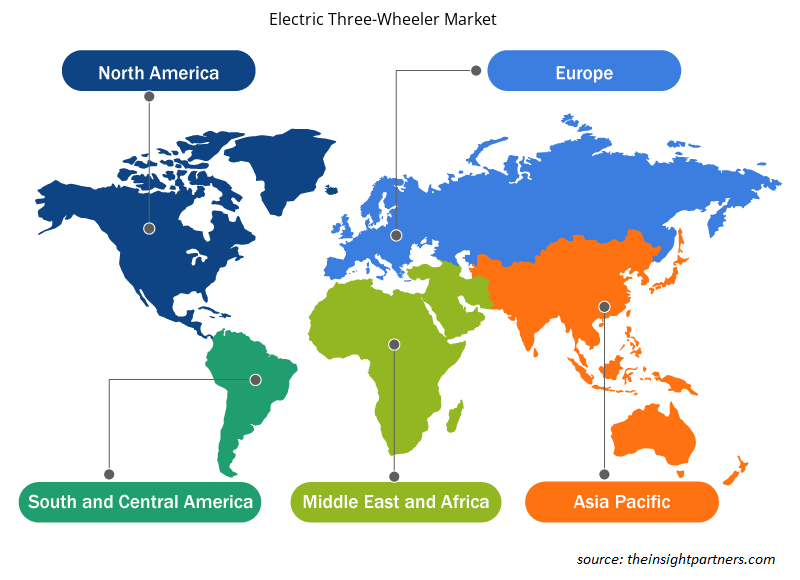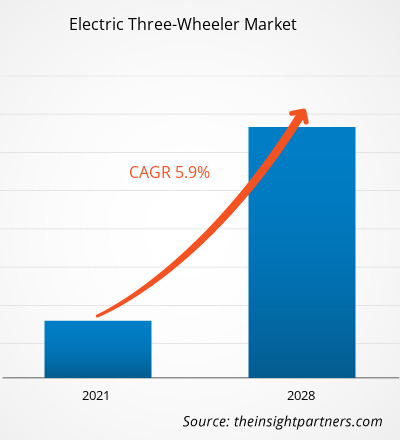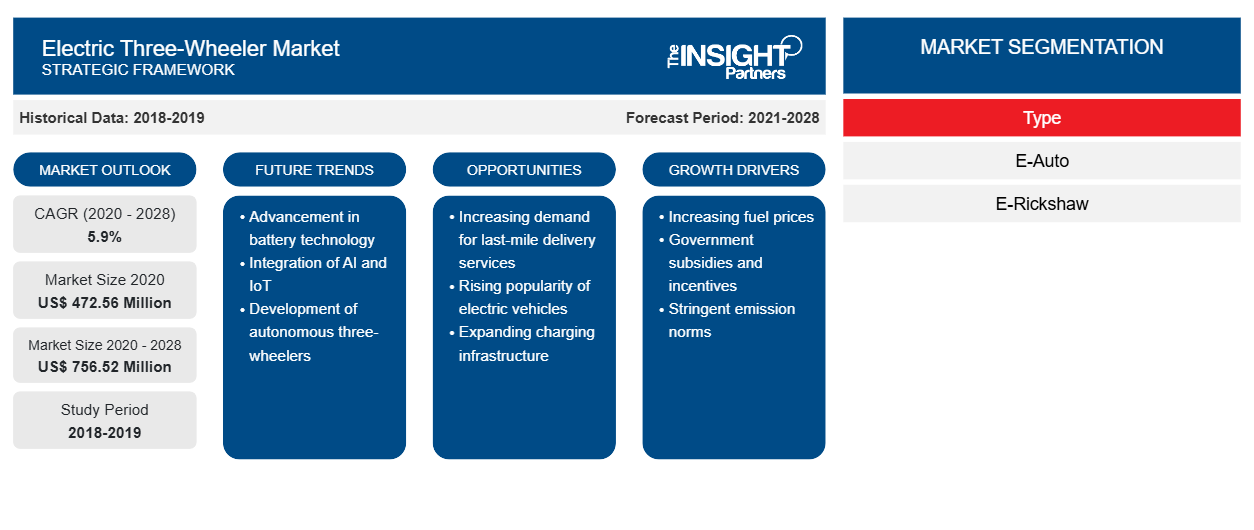بلغت قيمة سوق المركبات الكهربائية ذات العجلات الثلاث 472.56 مليون دولار أمريكي في عام 2020، ومن المتوقع أن تصل إلى 756.52 مليون دولار أمريكي بحلول عام 2028؛ ومن المتوقع أن تنمو بمعدل نمو سنوي مركب قدره 5.9٪ من عام 2021 إلى عام 2028.
تُستخدم المركبات الكهربائية ذات العجلات الثلاث على نطاق واسع لنقل الركاب إلى وجهتهم المطلوبة وكذلك لنقل البضائع. تعمل هذه المركبات ذات العجلات الثلاث بمحركات كهربائية تعمل ببطاريات قابلة لإعادة الشحن. يمكن إعادة شحن البطاريات في محطة شحن كهربائية أو أي نقطة شحن أخرى. تتمتع العديد من البلدان ذات الدخل المنخفض والمتوسط في جميع أنحاء العالم بمعدل استخدام أعلى للمركبات ذات العجلات الثلاث ، والتي كانت تعمل في البداية بمحركات الاحتراق الداخلي ( IC ). لكن معظم هذه المركبات ذات العجلات الثلاث ذات محرك الاحتراق الداخلي أصبحت غير فعالة وقديمة. وقد دفع هذا الشركات المصنعة إلى زيادة إنفاقها على البحث والتطوير للمركبات ذات العجلات الثلاث الكهربائية . علاوة على ذلك، تحظى المركبات ذات العجلات الثلاث الكهربائية بشعبية كبيرة في المناطق الحضرية والضواحي خاصة لنقل عدد صغير من الركاب والبضائع المدمجة في فترة زمنية قصيرة. بعض العوامل الرئيسية التي تدفع نمو سوق المركبات ذات العجلات الثلاث الكهربائية هي القواعد واللوائح الحكومية الصارمة المتعلقة بمكافحة التلوث، والوعي المتزايد بالآثار الضارة للانبعاثات من المركبات التي تعمل بالديزل والبنزين، والقبول المتزايد للمركبات الكهربائية. نظرًا لأن البنزين والديزل من الموارد القابلة للاستنفاد، فقد بدأ الناس بالفعل في التفكير في بدائل أخرى محتملة. بدأت المركبات الكهربائية ذات العجلات الثلاث تحل محل المركبات ذات العجلات الثلاث التي تعمل بالبنزين والديزل. متوسط تكلفة صيانة وتشغيل المركبات الكهربائية ذات العجلات الثلاث أقل بكثير من المركبات التقليدية ذات العجلات الثلاث . ومع ذلك، فإن حزمة البطارية الثقيلة والمدى المنخفض للمسافة المقطوعة هي بعض مجالات القلق التي يواجهها مصنعو المركبات الكهربائية ذات العجلات الثلاث. تقطع المركبات الكهربائية ذات العجلات الثلاث مسافة تتراوح بين 125 و130 كيلومترًا مع شحن بطاريتها بالكامل، بينما تقطع المركبات التقليدية مسافة تتراوح بين 200 و220 كيلومترًا مع خزان وقود ممتلئ.
سيطرت منطقة آسيا والمحيط الهادئ على سوق المركبات الكهربائية ثلاثية العجلات في عام 2020. تعد الهند واحدة من أكبر المساهمين في سوق المركبات الكهربائية ثلاثية العجلات في المنطقة. تنمو صناعة المركبات منخفضة الانبعاثات في البلاد بسرعة على خلفية المبادرات المواتية من قبل الحكومات بالإضافة إلى الوجود القوي لمصنعين مثل Mahindra & Mahindra و Atul Auto و Piaggio و Lohia Auto. سينفق مخطط التبني والتصنيع الأسرع للسيارات الهجينة والكهربائية II (FAME II)، بميزانية تبلغ 1.4 مليار دولار أمريكي ، 1.19 مليار دولار أمريكي على تمكين الخصومات المقدمة على مشتريات المركبات الكهربائية و 1.9 مليون دولار أمريكي على تعزيز تنفيذ البنية التحتية للشحن. لتلبية الطلب، ستفيد هذه التدابير 0.5 مليون مركبة كهربائية ثلاثية العجلات .
قم بتخصيص هذا التقرير ليناسب متطلباتك
ستحصل على تخصيص لأي تقرير - مجانًا - بما في ذلك أجزاء من هذا التقرير، أو تحليل على مستوى الدولة، وحزمة بيانات Excel، بالإضافة إلى الاستفادة من العروض والخصومات الرائعة للشركات الناشئة والجامعات
- احصل على أهم اتجاهات السوق الرئيسية لهذا التقرير.ستتضمن هذه العينة المجانية تحليلاً للبيانات، بدءًا من اتجاهات السوق وحتى التقديرات والتوقعات.
تأثير جائحة كوفيد-19 على سوق المركبات الكهربائية ثلاثية العجلات
لقد تسبب تفشي فيروس كورونا المستجد (كوفيد-19) في تعطيل سلسلة التوريد وتصنيع المعدات الإلكترونية بشدة، بما في ذلك المكونات المادية للمركبات الكهربائية ذات الثلاث عجلات . وبناءً على ظهور فيروس كورونا المستجد (كوفيد-19) في جميع أنحاء العالم، متبوعًا بسيناريوهات الإغلاق ، توقع خبراء صناعة السيارات أن تواجه الصناعة ربع تأخير على الأقل في سلسلة توريد المعدات الإلكترونية. ومن المرجح أن تستعيد صناعة المعدات الإلكترونية والسيارات وتيرتها بعد فترة وجيزة من رفع الحكومات لتدابير الاحتواء المختلفة، الأمر الذي من شأنه أن يساعد في إنعاش الاقتصادات. ومن المتوقع أن يكتسب إنتاج المعدات الإلكترونية ومنتجات السيارات زخمًا من عام 2021، وهو ما من المتوقع أن يؤثر بشكل إيجابي على تصنيع المعدات الإلكترونية والسيارات، بما في ذلك المكونات المادية للمركبات الكهربائية ذات الثلاث عجلات .
رؤى السوق
ارتفاع مستويات الغازات الضارة وإدارة التكلفة وقبول التقنيات النظيفة
إن ارتفاع مستوى الغازات الضارة، وإدارة التكاليف، وقبول التقنيات الأكثر نظافة من بين العوامل الرئيسية التي تساهم في نمو سوق المركبات الكهربائية ذات الثلاث عجلات. إن تبني المركبات الكهربائية يمكن أن يقلل بشكل كبير من انبعاث الملوثات في البيئة، وبالتالي تحسين جودة الهواء. لتقليل انبعاث الغازات المسببة للانحباس الحراري العالمي عن طريق احتراق وقود المركبات، تقدم الهيئات التنظيمية في جميع أنحاء العالم مزايا ضريبية وحوافز لزيادة تبني المركبات الصديقة للبيئة. أعلنت جميع البلدان الرائدة تقريبًا عن إعانات وحوافز مالية لجذب الشركات المصنعة لإنتاج المزيد من المركبات الكهربائية محليًا. كما تجتذب الإعفاءات الضريبية والخصومات العديد من المستخدمين المحليين لشراء المركبات الكهربائية ومن المرجح أن تؤدي إلى ظهور ما لا يقل عن 60٪ من المركبات الخضراء على الطريق بحلول عام 2020، وبالتالي تقليل انبعاثات الوقود وخفض الاعتماد على المنتجات البترولية. لقد نفذت الهيئات التنظيمية في الصين والهند وكوريا الجنوبية وإندونيسيا وبنجلاديش برامج مختلفة لتعزيز مبيعات المركبات الكهربائية ذات الثلاث عجلات. على سبيل المثال، في مارس 2018، أطلقت وزارة الصناعات الثقيلة والمؤسسات العامة في الهند المرحلة الثانية من مخطط FAME India، والذي حصل على دعم مالي إجمالي قدره 1.39 مليار دولار أمريكي. تهدف هذه المرحلة إلى دعم 500000 مركبة ثلاثية العجلات كهربائية؛ و55000 سيارة ركاب كهربائية رباعية العجلات؛ و7000 حافلة كهربائية؛ و100000 مركبة كهربائية ذات عجلتين من خلال الإعانات. تهدف هذه المرحلة من مخطط FAME إلى إنشاء بنية تحتية مناسبة للشحن العام لتعزيز تبني المركبات الكهربائية بين الجماهير. وبهذا، تتوقع وزارة الصناعات الثقيلة والمؤسسات العامة مشاركة وفعالية من مجموعة واسعة من أصحاب المصلحة، بما في ذلك مؤسسات القطاع العام والوكالات الحكومية.
رؤى السوق القائمة على النوع
تنقسم سوق المركبات الكهربائية ذات الثلاث عجلات، حسب النوع، إلى السيارات الكهربائية (عالية السرعة) والعربات الكهربائية ذات السرعة المنخفضة. تصدرت فئة عربات الركشة الكهربائية السوق في عام 2020. عربات الركشة الكهربائية هي مركبات كهربائية ذات ثلاث عجلات ذات طاقة أقل، ولديها سعة بطارية أقل مقارنة بالسيارات الكهربائية.
تعد تطويرات المنتجات ومبادرات السوق من الاستراتيجيات التي تتبناها الشركات بشكل شائع لتوسيع محفظة منتجاتها. تعد Piaggio & C. SpA وTerra Motors Corporation وKinetic Green Energy & Power Solutions Ltd. وLOHIA AUTO INDUSTRIES وMahindra Electric Mobility Limited من بين اللاعبين الرئيسيين الذين ينفذون استراتيجيات لتوسيع قاعدة العملاء والحصول على حصة كبيرة في سوق المركبات الكهربائية ذات الثلاث عجلات العالمية، مما يسمح لهم بدوره بالحفاظ على اسم علامتهم التجارية. فيما يلي بعض التطورات الرئيسية الأخيرة:
- في أكتوبر 2020، أعلنت شركة Mahindra Electric Mobility Ltd عن إطلاق طرازها الجديد من المركبات الكهربائية ذات الثلاث عجلات - Treo Zor - في الهند. بناءً على منصة Treo المجربة، سيتم توفير البضائع في 3 إصدارات - شاحنة صغيرة وشاحنة توصيل وشاحنة ذات منصة مسطحة.
- في فبراير 2018، أعلنت شركة Mahindra & Mahindra Ltd وشركة LG Chem عن تعاونهما في مجال تكنولوجيا بطاريات الليثيوم أيون المتقدمة.
رؤى إقليمية حول سوق المركبات الكهربائية ثلاثية العجلات
لقد قام المحللون في Insight Partners بشرح الاتجاهات والعوامل الإقليمية المؤثرة على سوق المركبات ذات الثلاث عجلات الكهربائية طوال فترة التوقعات بشكل شامل. يناقش هذا القسم أيضًا قطاعات سوق المركبات ذات الثلاث عجلات الكهربائية والجغرافيا في جميع أنحاء أمريكا الشمالية وأوروبا ومنطقة آسيا والمحيط الهادئ والشرق الأوسط وأفريقيا وأمريكا الجنوبية والوسطى.

- احصل على البيانات الإقليمية المحددة لسوق المركبات الكهربائية ثلاثية العجلات
نطاق تقرير سوق المركبات الكهربائية ثلاثية العجلات
| سمة التقرير | تفاصيل |
|---|---|
| حجم السوق في عام 2020 | 472.56 مليون دولار أمريكي |
| حجم السوق بحلول عام 2028 | 756.52 مليون دولار أمريكي |
| معدل النمو السنوي المركب العالمي (2020 - 2028) | 5.9% |
| البيانات التاريخية | 2018-2019 |
| فترة التنبؤ | 2021-2028 |
| القطاعات المغطاة | حسب النوع
|
| المناطق والدول المغطاة | أمريكا الشمالية
|
| قادة السوق وملفات تعريف الشركات الرئيسية |
|
كثافة اللاعبين في سوق المركبات الكهربائية ثلاثية العجلات: فهم تأثيرها على ديناميكيات الأعمال
يشهد سوق المركبات الكهربائية ثلاثية العجلات نموًا سريعًا، مدفوعًا بالطلب المتزايد من المستخدم النهائي بسبب عوامل مثل تفضيلات المستهلكين المتطورة والتقدم التكنولوجي والوعي المتزايد بفوائد المنتج. ومع ارتفاع الطلب، تعمل الشركات على توسيع عروضها والابتكار لتلبية احتياجات المستهلكين والاستفادة من الاتجاهات الناشئة، مما يؤدي إلى زيادة نمو السوق.
تشير كثافة اللاعبين في السوق إلى توزيع الشركات أو المؤسسات العاملة في سوق أو صناعة معينة. وهي تشير إلى عدد المنافسين (اللاعبين في السوق) الموجودين في مساحة سوق معينة نسبة إلى حجمها أو قيمتها السوقية الإجمالية.
الشركات الرئيسية العاملة في سوق المركبات الكهربائية ثلاثية العجلات هي:
- شركة جوينكا للسيارات الكهربائية المحدودة
- بياجيو آند سي. إس. بي. إيه
- شركة تيرا موتورز
- كينتيك جرين إنيرجي آند باور سوليوشنز المحدودة
- لوهيا لصناعة السيارات
إخلاء المسؤولية : الشركات المذكورة أعلاه ليست مرتبة بأي ترتيب معين.

- احصل على نظرة عامة على أهم اللاعبين الرئيسيين في سوق المركبات ذات الثلاث عجلات الكهربائية
تجزئة سوق المركبات الكهربائية ثلاثية العجلات:
حسب النوع
- إي أوتو (سرعة عالية)
- عربة الركشة الكهربائية (سرعة منخفضة)
نبذة عن الشركة
- شركة جوينكا للسيارات الكهربائية المحدودة
- بياجيو آند سي. إس. بي. إيه
- شركة تيرا موتورز
- كينتيك جرين إنيرجي آند باور سوليوشنز المحدودة
- لوهيا لصناعة السيارات
- شركة مجموعة بودو للسيارات المحدودة
- سيارات نوبي
- شركة ماهيندرا للتنقل الكهربائي المحدودة
- مصنع إي توك بي في
- جيانغسو كينغبون للسيارات المحدودة
- التحليل التاريخي (سنتان)، سنة الأساس، التوقعات (7 سنوات) مع معدل النمو السنوي المركب
- تحليل PEST و SWOT
- حجم السوق والقيمة / الحجم - عالمي، إقليمي، بلد
- الصناعة والمنافسة
- مجموعة بيانات إكسل
التقارير الحديثة
تقارير ذات صلة
شهادات العملاء
سبب الشراء
- اتخاذ قرارات مدروسة
- فهم ديناميكيات السوق
- تحليل المنافسة
- رؤى العملاء
- توقعات السوق
- تخفيف المخاطر
- التخطيط الاستراتيجي
- مبررات الاستثمار
- تحديد الأسواق الناشئة
- تحسين استراتيجيات التسويق
- تعزيز الكفاءة التشغيلية
- مواكبة التوجهات التنظيمية





















 احصل على عينة مجانية ل - سوق المركبات الكهربائية ثلاثية العجلات
احصل على عينة مجانية ل - سوق المركبات الكهربائية ثلاثية العجلات